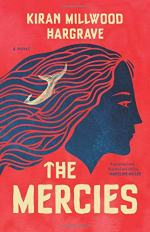|
This section contains 698 words (approx. 2 pages at 400 words per page) |

|
The Mercies Summary & Study Guide Description
The Mercies Summary & Study Guide includes comprehensive information and analysis to help you understand the book. This study guide contains the following sections:
This detailed literature summary also contains Quotes and a Free Quiz on The Mercies by Kiran Millwood Hargrave.
The following version of this book was used to create this guide: Hargrave, Kiran Millwood. The Mercies. Little, Brown and Company, 2019.
Kiran Millwood Hargrave’s The Mercies is a historical fiction novel which reimagines the real-life storm and witch trials which devastated the tiny village of Vardø, Norway, in the early 17th century. When the novel opens, Maren is a 20-year-old woman living with her Mother, Father, brother Erik, and Erik’s pregnant wife, Diinna. Maren is engaged to a young man named Dag Bjørnsson. Maren has ominous, strange dreams involving a whale.
A storm arrives suddenly while almost all of the town’s men are on a fishing trip, killing everyone who was out to sea, including Maren’s father, brother, and fiancé. Initially, the women are band together to survive, though there are clear power lines drawn between Kirsten Sørensdatter, a daring, headstrong woman who flouts gender roles, and Toril Knudsdatter, a stern, religious woman who becomes more hostile and devout as time goes on. A somewhat inept, middling Pastor, Pastor Kurtsson, comes to Vardø and subsequently announces that the town will soon have a new Commissioner, who will come to root out non-Christian influences, and though he does not say so explicitly, it is understood the commissioner will also be trying to root out any Sámi influences, including Diinna.
The Commissioner turns out to be Scotsman Absalom Cornet, infamous for a prior witch trial where he personally oversaw and participated in the beating, torture, branding, and eventual execution of a twelve-year-old girl. Cornet travels to Bergen, Norway, to find a wife before he goes to Vardø and settles on 20-year-old Ursa. Ursa is given little choice in the matter of marriage and dreads leaving behind her father and sickly younger sister, Agnete. Ursa and Cornet travel on a boat to Vardø, where Ursa suffers a miscarriage.
Ursa and Cornet arrive in Vardø. As Cornet begins surveying the village, making note of the non-church attenders and local Sámi population (particularly Diinna, since she is both), Ursa realizes that she knows nothing about how to keep a house or make food, especially in the harsh Vardø landscape. She hires Maren to teach her and the two become extremely close, with both women harboring secret romantic and sexual feelings toward each other. At the same time, Maren’s mother and Diinna become more and more antagonistic toward each other, with Maren forced to intercede between them. Worried for both her and her son’s future, Diinna decides to secretly leave Vardø, wishing Maren well before she goes.
Cornet begins a formal investigation into supposed witchcraft in Vardø. Toril, some of her kirke-women, and Maren’s mother formally accuse Fru Olufsdatter (Dag’s mother) and Kirsten of witchcraft, and of conspiring to bring on the storm. The two women are arrested and tortured. Kirsten is subject to a “ducking” where she is thrown in the water as a barbaric test for witchcraft. She is tried and sentenced to death, and burned at the stake. At this horrible sight, Toril and Maren’s mother appear to reconsider what they have done and feel guilt.
Maren and Ursa physically consummate their relationship amidst the chaos. Maren learns that she has been accused of witchcraft and runs back to Ursa, only to find her with Cornet. Cornet, drunk, accuses Maren of bewitching Ursa and tries to forcibly drown her, holding her head under bathwater. Ursa tries to pull him off of her, and winds up killing him to save Maren’s life. Maren decides to run away, knowing that as she is being accused of witchcraft she will also be blamed for Cornet’s death. Ursa wants to run away with her, but Maren forces her to stay behind so she can return to Bergen. The two women say goodbye, and Maren goes to the cliff, considering jumping. Her fate is left ambiguous. A brief author’s note at the end of the novel gives some historical context: the witch trials were real, as was the storm, and as a result nearly a hundred people were killed in the name of rooting out evil.
Read more from the Study Guide
|
This section contains 698 words (approx. 2 pages at 400 words per page) |

|



